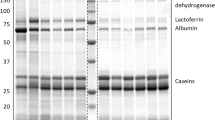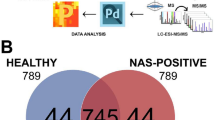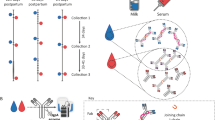Abstract
SINCE the demonstration by Aschaffenburg and Drewry1,2 that β-lactoglobulins of cow's milk occur in two different forms, ‘A’ and ‘B’, many attempts have been made to find the differences in the primary structure of these two protein types. The differences between the two genetic species have been shown3,4 to lie in the contents of four amino-acids, namely, aspartic acid, valine, glycine and alanine, β-lactoglobulin A having one more residue each of aspartic acid and valine and one less residue each of glycine and alanine than β-lactoglobulin B per half molecule. Likewise, chymotryptic peptide pattern analyses of sulphonated β-lactoglobulins A and B have indicated similarity of peptide pattern except for a single pair in which one aspartic acid residue in ‘A’ is replaced by one glycine residue in the corresponding ‘B’ peptide5. Information regarding the buffalo β-lactoglobulin, on the other hand, is scanty. It has been reported6,7 that cow β-lactoglobulin B and buffalo β-lactoglobulin have approximately the same molecular weight and are practically indistinguishable in crystal form, electrophoresis, sedimentation and ultra-violet absorption.
This is a preview of subscription content, access via your institution
Access options
Subscribe to this journal
Receive 51 print issues and online access
$199.00 per year
only $3.90 per issue
Buy this article
- Purchase on Springer Link
- Instant access to full article PDF
Prices may be subject to local taxes which are calculated during checkout
Similar content being viewed by others
References
Aschaffenburg, R., and Drewry, J., Nature, 176, 218 (1955).
Aschaffenburg, R., and Drewry, J., Nature, 180, 376 (1957).
Gordon, W. G., Basch, J. J., and Kalan, E. B., J. Biol. Chem., 236, 2908 (1961).
Piez, K. A., Davie, E. W., Folk, J. E., and Gladner, J. A., J. Biol. Chem., 236, 2911 (1961).
Kalan, E. B., Gordon, W. G., Basch, J. J., Townend, R., Arch. Biochem. Biophys., 96, 376 (1962).
Sen, A., and Sinha, N. K., Nature, 190, 343 (1961).
Bhattacharya, S. D., Roychoudhury, A. K., Sinha, N. K., and Sen, A., Nature, 197, 797 (1963).
Larson, B. L., and Jenness, Robert in Biochemical Preparations, 4, 23 (John Wiley and Sons, New York, 1955).
Van der Helm, H. J., Onderzoekingen over Enige Dierlijke Foetale Haemoglobinen (University of Groningen, 1958).
Weil, L., and Siebens, T. S., Arch. Biochem. Biophys., 84, 244 (1959).
Ingram, V. M., Biochim. Biophys. Acta, 28, 539 (1958).
Barnabas, J., and Muller, C. J., Nature, 194, 931 (1962).
Beaven, G. H., and Holiday, E. R., in Advances in Protein Chemistry, 7, 319, edit. by Anson, M. L., and Edsall, J. T. (Academic Press, New York, 1952).
Author information
Authors and Affiliations
Rights and permissions
About this article
Cite this article
MAWAL, R., BARNABAS, T. & BARNABAS, J. Identity of Cow β-Lactoglobulin ‘B’ and Buffalo β-Lactoglobulin. Nature 205, 175–176 (1965). https://doi.org/10.1038/205175a0
Published:
Issue Date:
DOI: https://doi.org/10.1038/205175a0
Comments
By submitting a comment you agree to abide by our Terms and Community Guidelines. If you find something abusive or that does not comply with our terms or guidelines please flag it as inappropriate.



